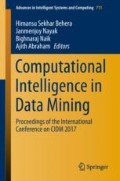Abstract
In this paper, we address the problem of recovering the shape and motion parameters of non-rigid shape from the 2D observations considering orthographic projection camera model. This problem is nonlinear in nature and the gradient-based optimization algorithms may easily stick in local minima on the other hand and the generic model fitting may result inexact shape. We propose Fibonacci population degeneration particle swarm optimization (fpdPSO) algorithm and used to estimate the shape and motion. We report the shape estimation results on face and shark data set. Pearson Correlation Coefficient is used to measure the accuracy of depth estimation.
Access this chapter
Tax calculation will be finalised at checkout
Purchases are for personal use only
References
Bowyer, Kevin W., Kyong Chang, and Patrick Flynn. “A survey of approaches and challenges in 3D and multi-modal 3D + 2D face recognition.” Computer vision and image understanding 101.1 (2006): 1–15.
Levine, Martin D., and Yingfeng Chris Yu. “State-of-the-art of 3D facial reconstruction methods for face recognition based on a single 2D training image per person.” Pattern Recognition Letters 30.10 (2009): 908–913.
Ullman, Shimon. “The interpretation of visual motion.” (1979), MIT Press.
Tomasi, Carlo, and Takeo Kanade. Shape and motion from image streams: a factorization method: full report on the orthographic case. Cornell University, 1992.
Bregler, Christoph, Aaron Hertzmann, and Henning Biermann. “Recovering non-rigid 3D shape from image streams.” Computer Vision and Pattern Recognition, 2000. Proceedings. IEEE Conference on. Vol. 2. IEEE, 2000.
Torresani, Lorenzo, Aaron Hertzmann, and Christoph Bregler. “Nonrigid structure-from-motion: Estimating shape and motion with hierarchical priors.” Pattern Analysis and Machine Intelligence, IEEE Transactions on 30.5 (2008): 878–892.
Koo, Hei-Sheung, and Kin-Man Lam. “Recovering the 3D shape and poses of face images based on the similarity transform.” Pattern Recognition Letters 29.6 (2008): 712–723.
Sun, Zhanli, and Kin-Man Lam. “Depth estimation of face images based on the constrained ICA model.” Information Forensics and Security, IEEE Transactions on 6.2 (2011): 360–370.
Sun, Zhan-Li, Kin-Man Lam, and Qing-Wei Gao. “Depth estimation of face images using the nonlinear least-squares model.” Image Processing, IEEE Transactions on 22.1 (2013): 17–30.
Chandar, Kothapelli Punnam, and Tirumala Satya Savithri. “3D Structure Estimation Using Evolutionary Algorithms Based on Similarity Transform.” Modelling Symposium (AMS), 2014 8th Asia. IEEE, 2014.
Ahlberg, Jörgen. “An active model for facial feature tracking.” EURASIP Journal on applied signal processing 2002.1 (2002): 566–571.
M. Hollander and D. A. Wolfe, Nonparametric Statistical Methods. New York: Wiley, 1973. Kirkpatrick Jr, S. “CDG, and Vecchi.” MP Optimization by simulated annealing 220 (1983): 671–680.
Kennedy, James, et al. Swarm intelligence. Morgan Kaufmann, 2001.
Author information
Authors and Affiliations
Corresponding author
Editor information
Editors and Affiliations
Rights and permissions
Copyright information
© 2019 Springer Nature Singapore Pte Ltd.
About this paper
Cite this paper
Punnam Chandar, K., Satya Savithri, T. (2019). Depth Estimation of Non-rigid Shapes Based on Fibonacci Population Degeneration Particle Swarm Optimization. In: Behera, H., Nayak, J., Naik, B., Abraham, A. (eds) Computational Intelligence in Data Mining. Advances in Intelligent Systems and Computing, vol 711. Springer, Singapore. https://doi.org/10.1007/978-981-10-8055-5_42
Download citation
DOI: https://doi.org/10.1007/978-981-10-8055-5_42
Published:
Publisher Name: Springer, Singapore
Print ISBN: 978-981-10-8054-8
Online ISBN: 978-981-10-8055-5
eBook Packages: Intelligent Technologies and RoboticsIntelligent Technologies and Robotics (R0)

